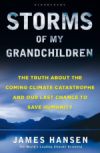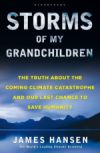 My gut reaction to all new sustainable business and climate change books is: “Eck. Get me some Percocet and vodka.” I already know what they’re going to say: the business books say green is green, sustainability is profitable, and here are some examples. The climate book says we are hosed, and we are going to have to tax and sequester carbon, and build windmills. I can’t take the climate books because they’re boring and depressing. I can’t take the green business books because they’re redundant and they lie, making it all look so easy.
My gut reaction to all new sustainable business and climate change books is: “Eck. Get me some Percocet and vodka.” I already know what they’re going to say: the business books say green is green, sustainability is profitable, and here are some examples. The climate book says we are hosed, and we are going to have to tax and sequester carbon, and build windmills. I can’t take the climate books because they’re boring and depressing. I can’t take the green business books because they’re redundant and they lie, making it all look so easy.
So why did I eagerly pick up a copy of James Hansen’s new book Storms of My Grandchildren: The Truth About the Coming Climate Catastrophe and Our Last Chance to Save Humanity? Isn’t that like hitting an ingrown toenail with a hammer?
Here’s why: In my office, I have a picture of a man testifying to Congress. He is haggard, with the look of someone under great strain. Behind him, engraved on the wall, is a quote from the book of Proverbs: “Where there is no vision, the people perish.” The man in the picture is NASA climatologist James Hansen, best known for bringing the danger of global climate change to the attention of the modern world in the 1980s, and widely considered the planet’s leading climatologist.
As you’d expect, Hansen’s book contains enough charts and graphs to choke a rhino. And there’s plenty of science, lots of it illuminating, even to jaded climate geeks like me. For example: How do we predict what a world with higher CO2 concentrations would look like? Do we use computers to create climate models? That’s one method, certainly. But we can find even more accurate information about what a warmed world will look like if we go back in time and rummage through the geologic record. The information we find there is extremely accurate. It shows that when it was only 1 degree Celsius warmer on average than now, the seas were several feet higher. Just 1 degree makes that much difference.
The science is fascinating, especially when presented in the context of a 30-year effort to make our government understand the dire need for aggressive action. But in the end, Hansen’s book is about something else. It’s about how one should live a life; the book is as much about Hansen’s answer to this philosophical question as it is about climate change.
Hansen is, on one hand, a remarkable man with an exceptional intellect, perhaps a once-in-a-millennium, perfectly timed comet of a person, like a Muhammad Ali or a Jonas Salk. On the other hand, he’s an everyman plagued with the same traits of regret and disappointment with himself that the rest of us also share. In the 1970s, the world’s greatest climate scientist once froze up while giving an overhead slide presentation and had to simply sit down, humiliated. Then, after giving a talk to the Bush-Cheney White House, he agonized about whether he should have ignored the cooling effects of aerosols because it gave Cheney an “out,” enabling him and others to make the specious argument that aerosols somehow balance out the trillions of tons of CO2 emitted every year.
Whatever his demons, Hansen repeatedly forces himself to do what he believes to be the right thing. Over and over, he swears that after one last effort to connect sound science to the policy it should inform, he’ll go back to the lab. Fortunately for us, he never does; his conviction overrules his reticence. This month, Hansen publicly defended Tim DeChristopher, the student who faces jail time for bidding on oil leases, without any money, to prevent drilling.
In his own office, it turns out, Hansen has a picture on the wall too. This shot is of Jackie Robinson and the legendary 1950s Dodgers. I expect that picture must inspire him as much as his picture inspires me. Jackie Robinson, a fulcrum in another battle to save a piece of civilization, is known for doing the impossible: not just integrating baseball, but for stealing home base: the consummate statement of daring, and hope, and confidence, and of simply being alive.
The task Hansen sets out for the reader — and for himself — in his book is similarly audacious: It is to take to the streets and save the planet. It’s a task of limitless difficulty, because it must overcome not only human inertia but also the fat-cat special interests and our glacially slow government. Hansen correctly notes that solving climate change is about solving money in politics, and that the future of democracy depends on addressing both.
As the book concludes, Hansen has just undergone surgery for prostate cancer. With his grandchildren, Sophie and Connor, he is planting milkweed for Monarch butterflies to nest in. Moving gingerly, working in the ancient Pennsylvania earth, accompanied by two breathing miracles of existence, Hansen must have felt the crushing beauty of the world, the crippling weight of mortality, the acute brevity and preciousness of life.
Hansen could have been content with just being a scientist. He could have done his work and felt — with justification — that he had contributed greatly to the world. This would have freed him from the personal attacks, the stress you can see plainly in his face, and the burden of being a living Cassandra, determined to try to change a world that stubbornly refuses to listen. But Hansen elected not to do that.
He chose, instead, to be a great man.


